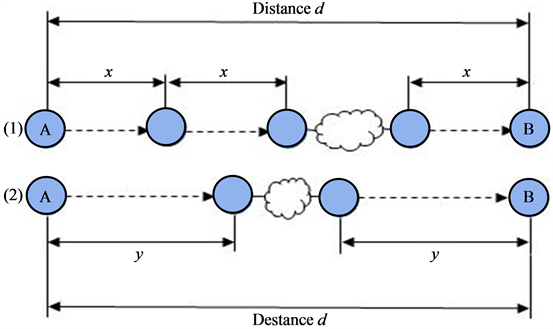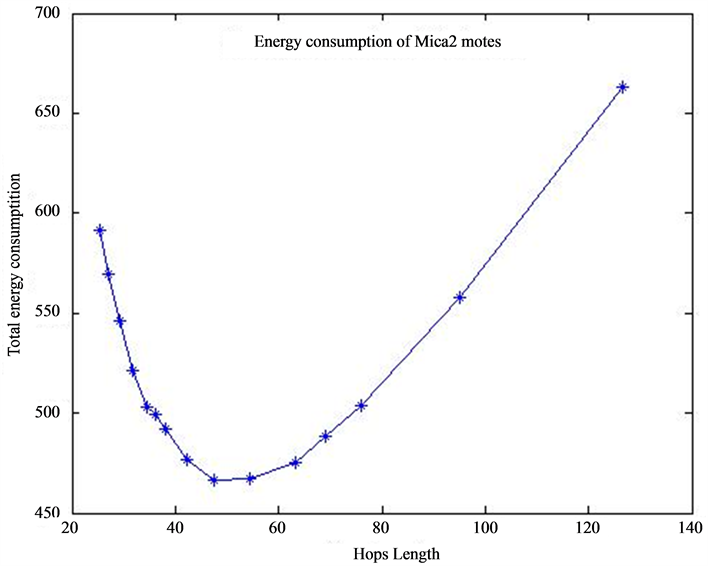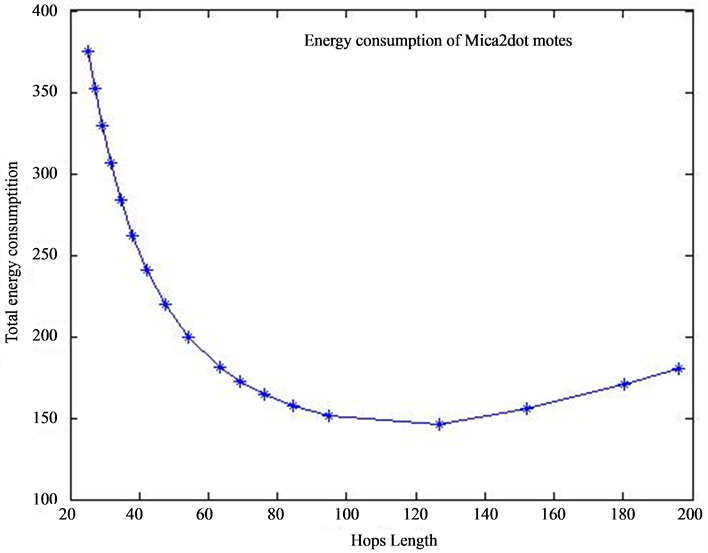Wireless Sensor Network
Vol.6 No.6(2014), Article
ID:47143,9
pages
DOI:10.4236/wsn.2014.66012
Analysis of Hops Length in Wireless Sensor Networks
Mekkaoui Kheireddine1, Rahmoun Abdellatif2
1Department of Computer Sciences, Dr. Tahar Moulay University, Saida, Algeria
2Department of Computer Sciences, Djillali Liabès University, Sba, Algeria
Email: mekdar@hotmail.com
Copyright © 2014 by authors and Scientific Research Publishing Inc.
This work is licensed under the Creative Commons Attribution International License (CC BY).
http://creativecommons.org/licenses/by/4.0/



Received 15 April 2014; revised 16 May 2014; accepted 17 June 2014
ABSTRACT
Wireless sensor networks are provided with a limited source of power. The lifetime of such networks is an overwhelming matter in most network applications. This lifetime depends strongly on how efficiently such energy is distributed over the nodes especially during transmitting and receiving data. Each node may route messages to destination nodes either through short hops or long hops. Optimizing the length of these hops may save energy, and therefore extend the lifetime of WSNs. In this paper, we propose a theorem to optimize the hop’s length so to make WSN power consumption minimal. The theorem establishes a simple condition on hop’s length range. Computer simulation when performing such condition on Mica2 sensors and Mica2dot sensors reveals good performance regarding WSNs energy consumption.
Keywords:Wireless Sensor Networks, Energy Efficiency, Multi-Hop Routing, Hop Length, Network’s Life Time

1. Introduction
In the last two decades, development in Micro-Electro-Mechanical Systems (MEMS) technology, electronics and wireless communications has permitted the development of wireless sensor nodes that are small in size, cheap and communicate via multi-hops scheme. These sensors, also known as motes, are generally composed of a power source (battery), a processing unit with limited capacity and a communication component (transceiver) [1] [2] . The deployment of these sensor nodes for the monitoring or the event detection in unattainable environment is known under wireless sensor networks (WSNs).
In the last years, WSNs have been used in many applications like military surveillance [3] , disaster management [4] , forest fire detection, seismic detection [5] , habitat monitoring, biomedical health monitoring [6] , inventory tracking, animal tracking, hazardous environment sensing and smart spaces, general engineering, commercial applications, home applications. Indeed, Business 2.0 lists sensor networks as one of six technologies that will change the world, and Technology Review at MIT and Global future identify WSNs as one of the 10 emerging technologies that will change the world [7] .
A sensor network is composed of large number of sensor nodes, which have priori positions fixed in a monitoring field or, generally, randomly deployed by a car, airplane or rocket launcher in inaccessible areas (volcano, seabed…). In the most case, it is infeasible to replace or change the node batteries according to the nature of the monitoring area; therefore each node has strict limitations in the usage of its electrical power, computation and memory resources. A sensor network should be very well-formed to achieve its purposes and to extend its life-time. Indeed how well the network is formed determines the life of the whole network as well as the quality of data transmission.
The nodes batteries in a WSN are considered as scarce resources and should be used efficiently, because of the random deployment of nodes, with limited batteries power, in difficult terrains. A sensor node consumes its battery power in sensing, receiving, sending and processing data; therefore the most energy-consuming component is the radio module that provides wireless communications [8] ; indeed, sending/receiving data consumes more energy than any other operation. The energy consumption when transmitting 1 bit of data on the wireless channel is similar to the energy required to execute thousands of cycles of CPU instructions [9] . Therefore, the energy efficiency of the communication protocol designed for WSN, affects largely the energy consumption and network life-time of wireless sensor networks [10] .
In the most times, sensor nodes in WSN do not have the necessary power and a sufficient communication range to reach the base station. So, the multi-hops mode of communication is used to forward data [8] . A graphical representation of wireless sensor networks is shown in Figure 1. Hence, a typical sensor node, don’t only sense and forward its own data but also have to act as a router i.e., to forward the data of its neighbors. Many papers in the literature showed that sending/receiving data consumes more energy than any other operation. It can be inferred that routing is one of the principal tasks in WSNs; therefore, good protocols should be developed in order to achieve maximum energy efficiency.
In nowadays, sensors are equipped with developed radio transceivers, which have the possibility to adjust their transmitting power, so some destinations can be reached with either a large number of smaller hops (multi-hops) or a small number of larger hops (single-hop) [6] . Energy efficiency of these two approaches depends on: the path loss between transmitter and receiver and power consumption of the radio transceiver in various operating modes [11] [12] .
The confusion over the required number of hops comes from the reality that each protocol (long-hops and short-hops routing) has its own advantages. Transmitting data over many short-hops minimizes the transmission energy which is proportional with the communication distance. However, transmitting data over long distance reduces the reception cost (as the number of nodes involved in data routing decreases).
2. Related Works
The issue of routing packets over long-hops or short-hops has been treated by many authors in the last years and their conclusions are varied depending on the criteria’s considered and the approach taken [13] . Some theoretical works [13] [14] showed that multi-hop routing is more efficient than single-hop routing; others showed the opposite in some real WSNs, the experimentations in these works showed that single-hop routing, can be much more energy efficient than multi-hop routing [15] [16] .
Yin et al. in [17] , presented two strategy of control, one of these methods consists of decreasing the transmission range of each node. According to the authors, using a route with many short-hops is generally more energy-efficient than one with a few long-hops; and will reduce the overall power consumption of the network.
In turn, Haengi specified many reasons why long-hops routing protocol is more energy efficient [18] . Haengi

Figure 1. Transmission distance for one hop.
claimed that although the transmitted energy drops significantly with distance diminution but the reduction of transmission power does not yield a decrease in the total energy consumption.
In this paper, we provide a simple condition; if respected, we will have the optimal length of hops that save more energy in WSNs. For this we need to define the most used model of the energy consumption, defined for the wireless sensor networks.
3. The Used Radio Model
A communication can be established between transmitter and receiver only when strength of the received radio signal is greater than the receiver antenna sensitivity threshold [18] . The diminution of the signal power density, between transmitter and receiver, is called path loss.
In this paper we use one of the most widely accepted and used models for network simulations and theoretical analysis. We use the log-distance path loss model presented in [5] [13] [18] . The power received by a remote node by meters from the sender can be expressed as follows:
 (1)
(1)
where:  is the received signal power at the distance
is the received signal power at the distance  from a transmitter and
from a transmitter and  is the path loss exponent, which is empirically measured under different propagation environments in [5] [13] . Typical values of path loss exponent in such environments are presented in Table1
is the path loss exponent, which is empirically measured under different propagation environments in [5] [13] . Typical values of path loss exponent in such environments are presented in Table1
In this paper, Equation (1) is used to define the minimum power required to communicate over a given distance between two nodes; after that a comparison is made between two routing strategies: long-hops and short-hops routing. When a node  transmits data to a node
transmits data to a node , the transmitted signal must be is equal to the sensitivity threshold
, the transmitted signal must be is equal to the sensitivity threshold  of the receiver to guarantee the signal detecting at the receiver [13] [14] .
of the receiver to guarantee the signal detecting at the receiver [13] [14] .
According to the Figure 1 we can therefore write:
 (2)
(2)
From which, we can get the signal energy required, which must be transmitted by the transmitter, to reach the destination:
 (3)
(3)
In [18] and the references therein, the authors assumed that during the data transmission only the transmitter is losing energy, the receiver doesn’t spend any energy during a reception. According to them, the short-hops strategy would be the most energy efficient, but since the necessary power for reception, when receiving a signal by a node, should not be neglected [8] [14] [19] , we will show in this paper that using long-hops strategy between two nodes (source and destination) is an optimal solution. This is due to the fact that saving power in transmission by the short multi-hops scheme doesn’t compensate the spent energy during the reception. The
energy spent by a node when receiving data can be equivalent to transmitting over a distant [14] . Thus the Formula:
 (4)
(4)
4. Short-Hops vs. Long-Hops Analysis
Figure 2 represents two topologies of multi-hop routing between two distant nodes, a source  and a destination
and a destination , with a distance
, with a distance . The first topology uses
. The first topology uses  hops to transmit data from
hops to transmit data from  to
to  (using
(using  short-hops of distance
short-hops of distance ); while the second uses
); while the second uses  hops (using
hops (using  long-hops of distance
long-hops of distance ); with
); with  (
( ), so we can write:
), so we can write:
 (5)
(5)
Since , Equation (5) becomes:
, Equation (5) becomes:
 (6)
(6)
Using Equation (3) and Equation (4), we can now compute the energy required to transmit a message  and
and . For the first topology, we have a path with
. For the first topology, we have a path with  hops. Thus we can express the power required to transmit data from
hops. Thus we can express the power required to transmit data from  to
to , using
, using  hops,
hops,  , as:
, as:

And it can be expressed, also, as:
 (7)
(7)
This can be written as:
 (8)
(8)
We know from Equation (6), that , therefore Equation (8) becomes:
, therefore Equation (8) becomes:
 (9)
(9)

Figure 2. Transmission distance for: (1) n-hops & (2) m-hops.
With the same way, we can get the power required to transmit data from  to
to  using
using  hops:
hops:
 (10)
(10)
Which equal to:
 (11)
(11)
5. Short-Hops vs. Long-Hops Comparison
In this section we present our main result. Let’s compute now :
:
 (12)
(12)
This is equal to:
 (13)
(13)
Since , therefore,
, therefore,  , if and if only:
, if and if only:
 (14)
(14)
Therefore:
 (15)
(15)
This means:
 (16)
(16)
And since , Equation (16) becomes:
, Equation (16) becomes:
 (17)
(17)
And since , inequalities (16) and (17) means that optimal energy consumption can be achieved when the hops lengths are included in the interval:
, inequalities (16) and (17) means that optimal energy consumption can be achieved when the hops lengths are included in the interval:
 (18)
(18)
6. Simulations and Results Validation
To validate the condition found in the previous section, we performed simulations with two different wireless sensor networks, the first-one is composed of Mica2 sensors and the second is composed of Mica2dot sensors. We used, in our simulations, the experimental characteristics of these two types of sensors, which are presented in [20] and described in Table2
In our simulations, we used Equation (3) to calculate the necessary energy to produce reachable signal by the receiver and Equation (4) to calculate the energy spent by a node when receiving data. We used also free space path loss exponent, which means , another assumption we made, is that the size of the all transmitted messages simulated WSNs have are fixed and equal to 15 bit.
, another assumption we made, is that the size of the all transmitted messages simulated WSNs have are fixed and equal to 15 bit.
6.1. First Case Study
To simulate the energy consumption of Mica2 sensors, we assumed the wireless sensor networks that are composed of aligned Mica2 nodes (Transmitter-Relays-Sink) with a length of 760 meters (distance between Transmitter and Sink), and we computed the energy consumed by these networks with different hops number, which means different hop lengths, which means also, different relays number. Computing the total consumed power by these different networks gave the results presented in Table3
We conclude from Table 3 that when the numbers of hops are between 11 and 20 hops the energy consumption is reduced; this is verified by our condition that limits the hops length in the interval . For easier reading, we present the results in the Figure 3.
. For easier reading, we present the results in the Figure 3.
6.2. Second Case Study
With the same way, we simulated the behaviors of Mica2dot sensors; we computed the consumed power for different aligned networks, with different hops length. We got the results presented in Table4

Figure 3. Mica2: Energy consumption vs. hops length.

Figure 4. Mica2dot: Energy consumption vs. hops length.
From Table 4 we can get the number of hops that makes energy consumption minimum, which is equal to 5, 6 or 8 hops; this result is verified, also, by our condition that limits the length of hops that ensure the minimum energy consumption in . For easier reading, we present the results in Figure 4.
. For easier reading, we present the results in Figure 4.
7. Conclusion
In this paper, we have analyzed the impact of the hop lengths on energy consumption in wireless sensor networks; we presented, also, the best hop length to reduce the energy consumption and thus extend the network life-time. The efficiency of the expressed condition in this paper is validated by the presented results of the simulations. Moreover, using the minimum hops length can be more efficient in the case of transmission failures that require retransmission. In future works we will focus on the problem of routing data by the less costly path in terms of energy, using the condition presented in this paper.
References
- Gerard, M. (2008) Smart Sensor Systems. John Wiley & Sons Inc., USA.
- Tom, K. (2005) Sensor Technology Handbook. John Wiley and Sons, USA.
- Pesovic, U.M., Mohorko, J.J., Benkic, K. and Cucej, Z.F. (2004) Sensor Network-Based Counter Sniper System. Proceedings of the 2nd International Conference on Embedded Networked Sensor Systems, New York, November 2004, 1-12.
- Castillo-Effer, M., Quintela, D.H., Moreno, W., Jordan, R. and Westhoff, W. (2004) Wireless Sensor Networks for Flash-Flood Alerting. Proceedings of 5th IEEE International Caracas Conference on Devices, Circuits and Systems, 1, 142-146. http://dx.doi.org/10.1109/ICCDCS.2004.1393370
- Theodore, S. (2009) Wireless Communications: Principles and Practice. IEEE Press, Piscataway.
- Lorincz, K., Malan, D.J., Fulford-Jones, T.R.F., Nawoj, A., Clavel, A., Shnayder, V., Mainland, G., Welsh, M. and Moulton, S. (2004) Sensor Networks for Emergency Response: Challenges and Opportunities. IEEE Pervasive Computing, 3, 16-23. http://dx.doi.org/10.1109/MPRV.2004.18
- Imad, M., et al. (2005) Handbook of Sensor Networks: Compact Wireless and Wired Sensing Systems. CRC Press, New York.
- Akyildiz, I.F. and Vuran, M.C. (2010) Wireless Sensor Networks. John Wiley and Sons, USA. http://dx.doi.org/10.1002/9780470515181
- Yick, J., Mukherjee, B. and Ghosal, D. (2008) Wireless Sensor Network Survey. Computer Network, 52, 2292-2330. http://dx.doi.org/10.1016/j.comnet.2008.04.002
- Mekkaoui, K. and Rahmoun, A. (2011) Short-Hops vs. Long-Hops—Energy Efficiency Analysis in Wireless Sensor Networks. Proceedings of the 3rd International Conference on Computer Science and Its Applications (CIIA’11), Saida, 13-15 December 2011, 13-15.
- Heinzelman, W.R., Chandrakasan, A. and Balakrishnan, H. (2000) Energy-Efficient Communication Protocol for Wireless Micro Sensor Networks. Proceedings of 33rd Hawaii International Conference on System Sciences, Washington, DC, 4-7 January 2000, 3005-3014. http://dx.doi.org/10.1109/HICSS.2000.926982
- Sohraby, K., et al. (2007) Wireless Sensor Networks: Technology, Protocols, and Applications. John Wiley & Sons, USA. http://dx.doi.org/10.1002/047011276X
- Fedor, S. and Collier, M. (2007) On the Problem of Energy Efficiency of Multi-Hop vs. One-Hop Routing in Wireless Sensor Networks. Proceedings of 21st International Conference on Advanced Information Networking and Applications Workshops, Washington, DC, 21-23 May 2007, 380-385. http://dx.doi.org/10.1109/AINAW.2007.272
- Neugebauer, M., Ploennigs, J. and Kabitzsch, K. (2006) Evaluation of Energy Costs for Single Hop vs. Multi Hop with Respect to Topology Parameters. 2006 IEEE International Workshop on Factory Communication Systems, Torino, 175-182. http://dx.doi.org/10.1109/WFCS.2006.1704148
- Haenggi, M. and Puccinelli, D. (2005) Routing in Ad Hoc Networks: A Case for Long Hops. IEEE Communications Magazine, 43, 93-101. http://dx.doi.org/10.1109/MCOM.2005.1522131
- Haenggi, M. (2004) Twelve Reasons Not to Route over Many Short Hops. Proceedings of IEEE 60th Vehicular Technology Conference, Piscataway, 26-29 September 2004, 3130-3134. http://dx.doi.org/10.1109/VETECF.2004.1404638
- Yin, B.L., Shi, H.C. and Yi S. (2005) A Two-Level Strategy for Topology Control in Wireless Sensor Networks. Proceedings of 11th International Conference on Parallel and Distributed Systems, Fukuoka, 22-22 July 2005, 358-362. http://dx.doi.org/10.1109/ICPADS.2005.57
- Pesovie, U.M., et al. (2010) Single-Hop vs. Multi-Hop Energy efficiency Analysis in Wireless Sensor Networks. Proceedings of 18th Telekomunikacioni forum TELFOR, Beograd, 23-25 Novembar 2010, 471-474.
- Boukerche, A. (2008) Algorithms and Protocols for Wireless Sensor Networks. John Wiley and Sons, New York.
- Anastasi, G., Falchi, A., Passarella, A., Conti, M. and Gregori, E. (2004) Performance Measurements of Motes Sensor Networks. Proceedings of 7th ACM International Symposium on Modeling, Analysis and Simulation of Wireless and Mobile Systems, New York, 174-181.


